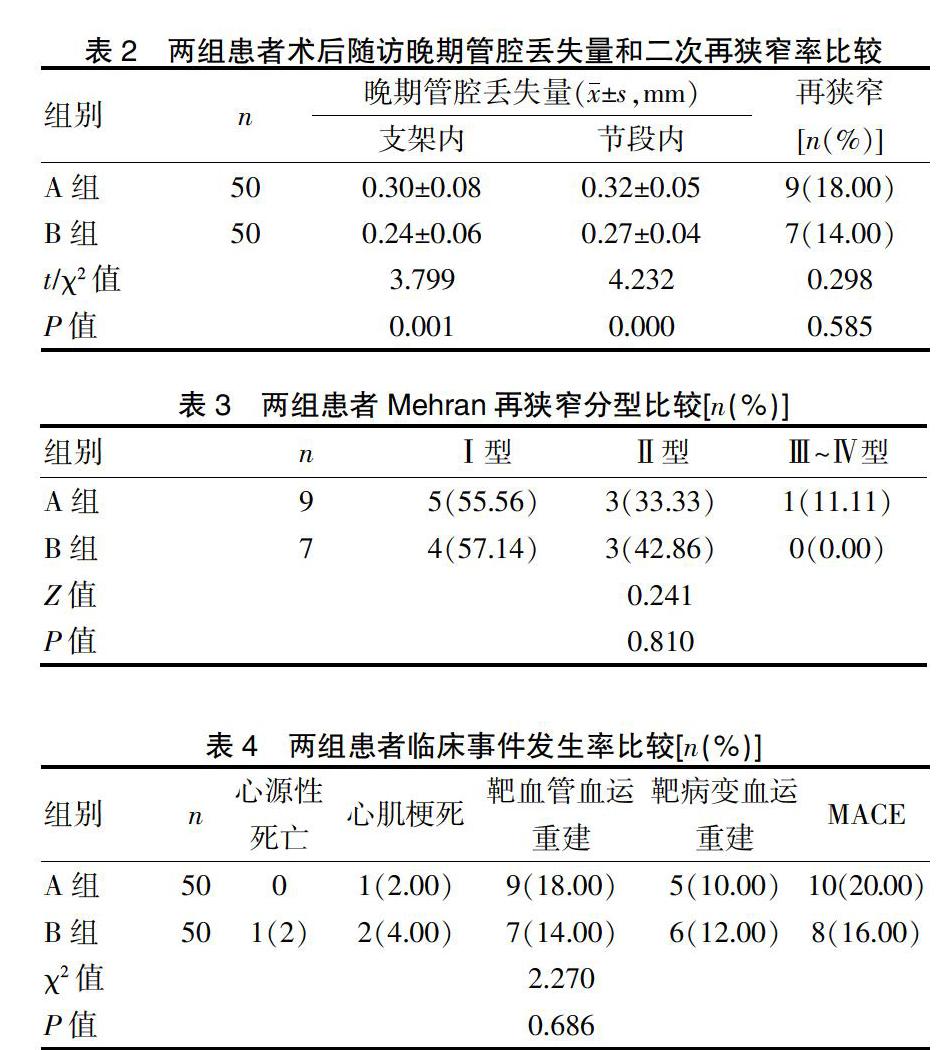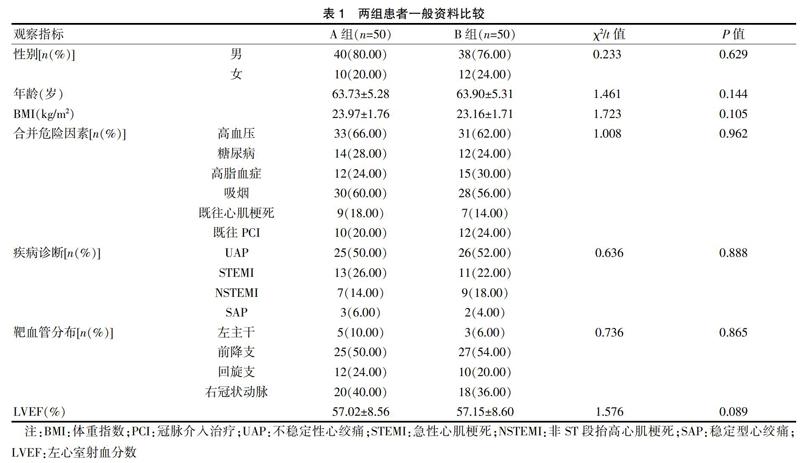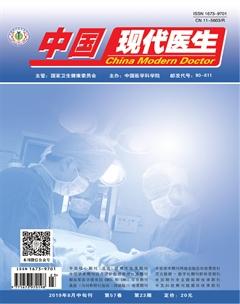两种治疗方案对支架内再狭窄患者冠脉造影效果及临床事件发生风险的影响
余小妹 杨栋 周莉 陈宇凯 王明伟


[摘要] 目的 探讨药物洗脱球囊和药物洗脱支架对支架内再狭窄患者冠脉造影效果及临床事件发生风险的影响。方法 选取我院2015年1月~2016年12月收治支架内再狭窄患者共100例为研究对象,根据治疗方案差异随机分为A组(50例)和B组(50例),A组患者采用药物洗脱支架治疗,B组患者采用药物洗脱球囊方案治疗;比较两组患者术后随访晚期管腔丢失量、二次再狭窄率、Mehran再狭窄分型及临床事件发生率。 结果 两组患者晚期管腔丢失量比较,B组晚期管腔丢失量较A组更少(P<0.05),两组二次再狭窄率比较,差异无统计学意义(P>0.05);两组患者Mehran再狭窄分型情况比较,差异无统计学意义(P>0.05);两组患者临床事件发生率比较,差异无统计学意义(P>0.05)。 结论 药物洗脱球囊治疗支架内再狭窄总体疗效不逊于药物洗脱支架,具有临床应用价值。
[关键词] 药物洗脱球囊;药物洗脱支架;支架内再狭窄;冠脉造影效果;临床事件
[中图分类号] R543 [文献标识码] A [文章编号] 1673-9701(2019)23-0015-04
[Abstract] Objective To investigate the effects of drug-eluting balloon and drug-eluting stent on coronary angiography and risk of clinical events in patients with in-stent restenosis. Methods A total of 100 patients with in-stent restenosis were enrolled in our hospital from January 2015 to December 2016. They were randomly divided into group A (50 cases) and group B(50 cases) according to the treatment plan, and the group A was treated with eluting stents, the group B was treated with drug-eluting balloon. The late lumen loss, secondary restenosis rate, Mehran restenosis classification, and clinical event rate were compared between the two groups during the postoperative follow-up. Results The amount of late luminal loss in group B was significantly less than that in the group A(P<0.05). There was no significant difference in the rate of secondary restenosis between the two groups(P>0.05).There was no significant difference in the classification of Mehran restenosis between the two groups(P>0.05). There was no significant difference in the incidence of clinical events between the two groups(P>0.05). Conclusion The drug-eluting balloon is not inferior to the drug-eluting stent in the treatment of in-stent restenosis, and has clinical application value.
[Key words] Drug-eluting balloon; Drug-eluting stent; In-stent restenosis; Coronary angiography effect; Clinical event
支架內再狭窄是行经皮冠脉介入治疗术(percutaneous coronary intervention,PCI)后亟需解决问题之一,近年来研究显示,药物洗脱球囊通过将球囊成形和药物洗脱技术相结合,输送球囊导管达病变血管壁内,可达到抑制平滑肌增生和降低狭窄程度的目的[1-2]。但对于支架内再狭窄防治药物洗脱球囊应用仍存在一定争议,不同回顾性研究间结论存在较大差异;部分学者报道其与药物洗脱支架应用比较具有相近临床疗效[3];而另一项研究则表明药物洗脱支架应用在治疗支架内再狭窄方面更具优势[4]。本文旨在探讨药物洗脱球囊和药物洗脱支架对支架内再狭窄患者冠脉造影效果及临床事件发生风险的影响,为治疗方案选择提供相应循证依据,现报道如下。
1 资料与方法
1.1 一般资料
选取我院2015年1月~2016年12月收治的支架内再狭窄患者共100例为研究对象,根据治疗方案差异分为A组(药物洗脱支架组)和B组(药物洗脱球囊组),每组50例;两组患者一般资料比较,差异无统计学意义(P>0.05)。见表1。
1.2 纳入标准
①既往行裸金属支(bare metal stent,BMS)或药物洗脱支架(drug-eluting stent,DES)治疗,复查见单支血管再狭窄;②年龄≥18岁;③符合球囊和支架置入适应证;④方案经医院伦理委员会批准,且患者及家属知情同意。
1.3 排除标准
①急性心肌梗死病程<48 h;②肾小球滤过率(GFR)<30 mL/min;③心力衰竭分级(New York Heart Association分级,NYHA分级)Ⅳ级;④研究药物过敏;⑤凝血功能障碍、外周动脉疾病及脑卒中;⑥临床资料不全。
1.4 治疗方法
全部患者术前3 d给予阿司匹林(拜耳医药,100 mg,J20080078)100 mg/d,氯吡格雷(赛诺菲制药,75 mg,J20130083)75 mg/d,口服;术中给予肝素(北京赛生药业,1.25万单位/支,H11020362)80~100 U/kg静脉滴注,保证活化凝血时间维持在200~250 s;根据治疗方法的不同随机分为A组和B组。
A组患者采用DES治疗,支架为美敦力医疗器械有限公司生产。DES治疗方法:造影明确狭窄部位后,工作角度下首先使用普通冠脉球囊预扩张,冠脉球囊直径一般小于狭窄两端正常血管直径0.5 mm,长度应该完全覆盖狭窄段;DES一般与狭窄两端正常血管直径相同,长度应超出狭窄两端1~2 mm,支架球囊充盈30 s。B组患者则采用药物洗脱球囊(drug-eluting balloon,DEB)治疗,DEB德国贝朗医疗有限公司生产,紫杉醇载药量3 μg/mm2。DEB治疗方法:使用普通冠脉球囊进行预扩张,球囊与狭窄两端正常血管直径比率0.8~1.0;普通球囊扩张后使用DEB进行扩张,一般DEB直径与普通冠脉球囊相同,长度要比狭窄两端各长1~2 mm,并且要完全覆盖狭窄段,一般DEB贴壁扩张持续30~60 s,扩张后再次造影观察狭窄解除情况。
1.5 观察指标
①术后6个月行冠状动脉造影记录晚期管腔丢失量,计算平均值。②记录患者术后6个月二次再狭窄例数,计算百分比。③根据Mehran分型,将支架内再狭窄分为4型[5]:Ⅰ型为局部型,支架内狭窄长度≤10 mm;Ⅱ型为弥漫型,支架内狭窄长度>10 mm;Ⅲ型为增生型,支架内狭窄长度>10 mm并超过支架边缘;Ⅳ型为闭塞型,即支架内完全闭塞。④记录患者术后随访心源性死亡、心肌梗死、靶血管血运重建、靶病变血运重建及主要不良心脏事件(major adverse cardiac events,MACE)例数,计算百分比。
1.6 统计学方法
数据分析选择SPSS18.0软件,计量资料采用t检验,进行检验前先进行正态性检验及方差齐性检验,若非正态分布或方差不齊,则采用秩和检验;计数资料采用χ2检验或精确概率法检验;等级资料采用秩和检验;P<0.05为差异有统计学意义。
2 结果
2.1 两组患者术后随访晚期管腔丢失量和二次再狭窄率比较
两组患者晚期管腔丢失量比较,无论是支架内还是节段内,B组晚期管腔丢失量较A组更少(P<0.05);但两组二次再狭窄率比较,差异无统计学意义(P>0.05)。见表2。
2.2 两组患者Mehran再狭窄分型比较
两组患者Mehran再狭窄分型情况比较,差异无统计学意义(P>0.05)。见表3。
2.3 两组患者临床事件发生率比较
两组患者临床事件发生率比较,差异无统计学意义(P>0.05)。见表4。
3 讨论
PCI术是急性冠脉综合征患者首选治疗方案之一,在延长生存时间的同时亦显著提高生活质量;但大量随访报道显示,患者术后极易出现支架再狭窄问题,严重影响远期预后改善[6]。目前医学界研究显示,支架内在狭窄发生机制较为复杂,可能原因包括[7-8]:①支架置入时对血管内膜造成损伤,部分中膜撕裂后可暴露内皮下组织,诱导血小板局部吸附聚集及血栓形成,而此类血栓可通过后续基质和胶原合成,加快新生内膜形成速率,最终导致支架内再狭窄发生;②支架置入导致的血管损伤还可激活外周循环中有丝分裂原,提高血小板功能,刺激平滑肌细胞增殖,而平滑肌细胞过度增殖已被证实是导致支架内再狭窄发生的关键原因;③支架进入人体后异物刺激可加重局部血管炎性反应,引起巨噬细胞聚集和内皮损伤进展。国外学者研究显示,前降支支架植入后较其他血管更易诱发再狭窄发生,这可能与血管解剖结构、血流与血管壁间剪切力形成等密切相关[9]。
目前临床对于支架再狭窄患者治疗方案选择尚存在较大争议,药物洗脱球囊应用能否达到药物洗脱支架相近或者更加良好的临床疗效并无明确定论。紫杉醇DEB含有紫杉醇混合对比剂,可通过携带的紫杉醇药物抑制血管内膜增生,减少ISR 发生率[10]。药物球囊药物洗脱球囊近年来被逐渐应用于支架内再狭窄治疗,并取得令人满意效果[11];其中含有紫杉醇药物成分能够有效抑制血管内膜增生,降低再狭窄发生风险;同时其还能够解决支架置入后膨胀不良所引起再狭窄问题,避免多层重叠支架植入[12];此外相较于药物洗脱支架,药物洗脱球囊应用后能够预防因支架药物不均匀可能诱发内皮化延迟和晚期血栓发生。但药物洗脱球囊难以解决急性期病变血管弹性回缩、置入后严重夹层形成可能等问题[13]。
国外学者研究显示[14],药物洗脱球囊治疗支架内再狭窄患者总体疗效优于普通球囊,随访6个月后晚期管腔丢失量更少;而另一项前瞻性研究则提示[15],药物洗脱球囊与药物洗脱支架在晚期管腔丢失控制方面效果相当。Habara S等[16]最新注册研究结果提示,治疗DES植入术后ISR 晚期管腔丢失明显优于DES 组;两组术后1 年MACE 发生率差异无统计学意义。国内学者在对比药物球囊和药物洗脱支架在治疗支架内狭窄的中心临床试验中显示,临床随访1年和2年的临床事件发生率均较药物洗脱支架低[17-19]。本研究结果中,两组患者二次再狭窄率比较,差异无统计学意义(P>0.05);两组患者Mehran再狭窄分型情况比较,差异无统计学意义(P>0.05),证实与药物洗脱支架相比,药物洗脱球囊治疗支架内再狭窄在避免再次狭窄和促进血管再通方面效果接近;同时两组患者临床事件发生率比较,差异无统计学意义(P>0.05),表明药物洗脱球囊用于支架内再狭窄患者治疗安全性值得认可,与以往报道结果相一致[20]。
本研究显示,药物洗脱球囊治疗支架内再狭窄总体疗效不逊于药物洗脱支架,具有临床应用价值。当然,本研究为单中心研究,并且样本量较小,需要更大样本量的多中心研究才能取得更可靠的结果。
[参考文献]
[1] Han Y,Xu B,Jing Q,et al. A randomized comparison of novel biodegradable polymer-and durable polymer-coated cobaltchromium sirolimus-eluting stents[J]. JACC Cardiovasc Interv,2014,7(12):1352-1360.
[2] Zhu L,Lv YN,Wang LY. Stent thrombosis with biodegradable polymer drug-eluting stents versus durable polymer sirolimus-eluting stents:an update meta-analysis[J]. Cardiology,2015,130(2):96-105.
[3] De la Torre Hernandez JM,Alfonso F,Sanchez Recalde A,et al. Comparison of paclitaxel-eluting stents (Taxus) and everolimus-eluting stents(Xience) in left main coronary artery disease with 3 years follow-up (from the ESTROFA-LM registry)[J]. Am J Cardiol,2013,111(4):676-683.
[4] Conrotto F,Scacciatella P,D'Ascenzo F,et al. Long-term outcomes of percutaneous coronary interventions or coronary artery bypass grafting for left main coronary artery disease in octogenarians(from a drug-eluting stent for left main artery registry substudy)[J]. Am J Cardiol,2014,113(4):2007-2012.
[5] Mehran R,Dangas G,Abizaid A,et al. Angiographic Patterns of In-Stent Restenosis:Classification and Implications for Long-Term Outcome[J]. Circulation,1999,100(18):1872-1878.
[6] Naganuma T,Chieffo A,Takagi K,et al. First generation versus new generation drug-eluting stents for the treatment of ostial/midshaft lesions in unprotected left main coronary artery:The Milan and New-Tokyo(MITO)registry[J]. Catheter Cardiovasc Interv,2015,85(3):E63-E69.
[7] Athappan G,Patvardhan E,Tuzcu ME,et al. Left main coronary artery stenosis: a meta-analysis of drug-eluting stents versus coronary artery bypass grafting[J]. JACC Cardiovasc Interv,2013,33(6):1219-1230.
[8] Tada T,Byrne RA,Cassese S,et al. Comparative efficacy of 2 zotarolimus-eluting stent generations: resolute versus endeavor stents in patients with coronary artery disease[J]. Am Heart J,2013,165(4):80-86.
[9] Sen H,Lam MK,Tandjung K,et al. Complex patients treated with zotarolimus-eluting resolute and everolimus-eluting xience V stents in the randomized TWENTE trial:Comparison of 2-year clinical outcome[J]. Catheter Cardiovasc Interv,2015,85(4):74-81.
[10] 張文俐,杜润,朱政斌,等.药物洗脱球囊抑制下肢动脉狭窄性病变的实验研究[J].介入放射学杂志,2014,23(5):423-426.
[11] Lee JM,Park KW,Han JK,et al. Three-year patient-related and stent-related outcomes of second-generation everolimus-eluting Xience V stents versus zotarolimus-eluting resolute stents in real-world practice(from the Multicenter Prospective EXCELLENT and RESOLUTE-Korea Registries)[J]. Am J Cardiol,2014,114(6):1329-1338.
[12] Cho SC,Jeong MH,Kim W,et al. Clinical outcomes of everolimus-and zotarolimus-eluting stents in patients with acute myocardial infarction for small coronary artery disease[J]. J Cardiol,2014,63(3):409-417.
[13] Bernelli C. Drug-eluting stents in unprotected left main coronary artery disease[J]. Expert Rev Cardiovasc Ther,2014,12(5):1349-1368.
[14] Buszman PP,Orlik B,Trela B,et al. Comparable clinical safety and efficacy of biodegradable versus durable polymer paclitaxel eluting stents despite shorter dual antiplatelet therapy:insights from a multicenter, propensity score-matched registry[J]. Catheter Cardiovasc Interv,2013,82(3):155-162.
[15] Serruys PW,Farooq V,Kalesan B,et al. Improved safety and reduction in stent thrombosis asociated with biodegradable polymer-based biolimus-eluting stents versus durable polymer-based sirolimus-eluting stents in patients with coronary artery disease:final 5-year report of the LEADERS(Limus Eluted From A Durable Versus ERodable Stent Coating)randomized,noninferiority trial[J].JACC Cardiovasc Interv,2013,6(7):777-789.
[16] Habara S,Kadota K,Kanazawa T,et al. Paclitaxel-coated balloon catheter compared with drug-eluting stent for drug-eluting stent restenosis in routine clinical practice[J].Euro Intervention,2016,11(10):1098-1105.
[17] Xu B,Gao R,Wang J,et al. A prospective,multicenter,randomized trial of paclitaxel-coated balloon versus paclitaxel-eluting stent for the treatment of drug-eluting stent in-stent restenosis:results from the PEPCAD China ISR trial[J]. JACC Cardiovasc Interv,2014,7(2):204-211.
[18] 崔孔勇,呂树铮,柳弘,等.紫杉醇药物洗脱球囊与西罗莫司药物洗脱支架治疗再狭窄的比较[J]. 心肺血管病杂志,2016,35(7):499-504.
[19] 曾书燚,王正东,陈坚,等.药物洗脱球囊与药物洗脱支架治疗支架内再狭窄疗效比较[J].介入放射学杂志,2017, 26(9):839-842.
[20] 曾书■,王正东,陈坚,等.药物洗脱球囊与药物洗脱支架治疗支架内再狭窄疗效比较[J].介入放射学杂志,2017,26(9):839-842.
(收稿日期:2018-10-25)

